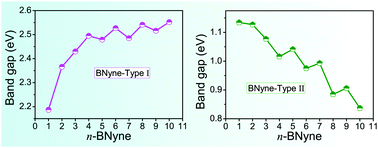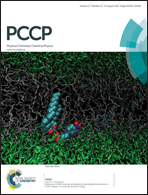Flexible band gap tuning of hexagonal boron nitride sheets interconnected by acetylenic bonds†
Abstract
The energetic and electronic properties of acetylenic-bond-interconnected hexagonal boron nitride sheets (BNyne), in which the number of rows of BN hexagonal rings (denoted as BN width) between neighboring arrays of acetylenic linkages increases consecutively, have been explored using first-principles calculations. Depending on the spatial position of B/N atoms with respect to the acetylenic linkages, there are two different types of configurations. The band structure features and band gap evolutions of BNyne structures as a function of the BN width can be categorized into two families, corresponding to two distinct types of configurations. In particular, for both types of BNyne structures, the band gap variations exhibit odd–even oscillating behavior depending on the BN width, which is related to the different symmetries of acetylenic chains in the unit cell. These results suggest that the embedded linear acetylenic chains can provide more flexibility for manipulation of the atomic and electronic properties of hexagonal boron nitride. These sp–sp2 hybrid structures might promise importantly potential applications for developing nanoscale electronic and optoelectronic devices.


 Please wait while we load your content...
Please wait while we load your content...